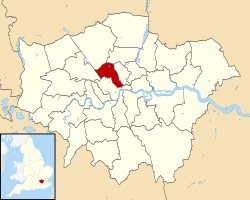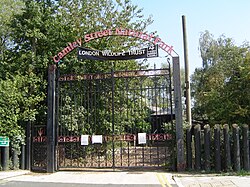The London Borough of Camden /ˈkæmdən/ is a borough of London, England, which forms part of Inner London. The southern reaches of Camden form part of central London. The local authority is Camden London Borough Council.
History

The borough was created in 1965 from the former area of the metropolitan boroughs of Hampstead, Holborn, and St Pancras, which had formed part of the County of London. The borough was named after Camden Town, which had gained its name from Charles Pratt, 1st Earl Camden in 1795. The transcribed diaries of William Copeland Astbury, recently made available, describe Camden and the surrounding areas in great detail 1829â€"1848.
There are 162 English Heritage blue plaques in the borough of Camden representing the many diverse personalities that have lived there.
Districts and environs
- For a full list of districts and neighbourhoods of Camden, see List of districts in Camden
The area is in the northern part of the city, reaching from Holborn and Bloomsbury in the south to Hampstead Heath in the north. Neighbouring areas are the City of Westminster and the City of London to the south, Brent to the west, Barnet and Haringey to the north and Islington to the east. It covers all or part of the N1, N6, N7, N19, NW1, NW2, NW3, NW5, NW6, NW8, EC1, WC1, WC2, W1 and W9 postcode areas. It contains parts of central London.
Politics

Camden London Borough Council
Camden Town Hall is located in Judd Street near King's Cross. Camden London Borough Council was controlled by the Labour Party continuously from 1971 until the 2006 election, when the Liberal Democrats became the largest party. In 2006, two Green Cllrs, Maya de Souza and Adrian Oliver, were elected (to Highgate Ward) and were the first Green Party councillors in Camden. In 1985 when the borough was rate-capped, the Labour leadership joined the rebellion in which it declared its inability to set a budget in an unsuccessful attempt to force the Government to allow higher spending. Camden was the fourth to last council to drop out of the campaign, doing so in the early hours of 6 June.
Borough councillors are elected every four years. Since May 2002 the electoral wards in Camden are Belsize, Bloomsbury, Camden Town with Primrose Hill, Cantelowes, Fortune Green, Frognal and Fitzjohns, Gospel Oak, Hampstead Town, Haverstock, Highgate, Holborn and Covent Garden, Kentish Town, Kilburn, King's Cross, Regent's Park, St Pancras and Somers Town, Swiss Cottage and West Hampstead.
Between 2006 and 2010 Labour lost two seats to the Liberal Democrats through by-elections, in Kentish Town and Haverstock wards. A Labour Councillor in Haverstock ward also defected to the Liberal Democrats in February 2009. The Conservatives also lost two seats, one to the Liberal Democrats in Hampstead, and one to the Green Party, Alexander Goodman, in Highgate, taking the total number of Green Party Councillors to three.
At the local elections on 6 May 2010 the Labour party regained full control of Camden council. The new council is made up of 30 Labour, 13 Liberal Democrats, 10 Conservatives and 1 Green councillors. At the Council's AGM, Labour's Nasim Ali took office as Camden's first leader from the Bengali community. Labour Councillor Jonathan Simpson was elected the Mayor of the Borough.
The organisation's staff are led by the Chief Executive who is currently Mike Cooke. The organisation is divided into five directorates:
- Housing and Adult Social Care
- Children, Schools and Families
- Culture & Environment
- Central Services:
- Finance
- Legal
- Strategy and Organisation Development
- Chief Executives Department
The directorates are headed by a director who report directly to the Chief Executive. Each directorate is divided into a number of divisions headed by an assistant director. They in turn are divided into groups which are themselves divided into services. This is a similar model to most local government in London.
London Assembly
Camden forms part of the Barnet and Camden London Assembly constituency, represented by Andrew Dismore of the Labour Party
UK Parliament
There are two parliamentary constituencies covering Camden: Hampstead and Kilburn in the north, represented by Labour's Tulip Siddiq, and Holborn and St. Pancras in the south, represented by Labour's Keir Starmer.
Demographics
In 1801, the civil parishes that form the modern borough were already developed and had a total population of 96,795. This continued to rise swiftly throughout the 19th century as the district became built up, reaching 270,197 in the middle of the century. When the railways arrived the rate of population growth slowed, for while many people were drawn in by new employment, others were made homeless by the new central London termini and construction of lines through the district. The population peaked at 376,500 in the 1890s, after which official efforts began to clear the overcrowded slums around St Pancras and Holborn.
After World War II, further suburban public housing was built to rehouse the many Londoners made homeless in the Blitz, and there was an exodus from London towards the new towns under the Abercrombie Plan for London (1944). As industry declined during the 1970s the population continued to decline, falling to 161,100 at the start of the 1980s. It has now begun to rise again with new housing developments on brownfield sites and the release of railway and gas work lands around Kings Cross.
The 2001 census gave Camden a population of 198,000, an undercount that was later revised to 202,600. The projected 2006 figure is 227,500.
On 20 May 1999, the Camden New Journal newspaper documented 'Two Camdens' syndrome as a high profile phenomenon differentiating the characteristics of education services in its constituencies. In 2006, Dame Julia Neuberger's book reported similar variation as a characteristic of Camden's children's health services. Her insider's view was corroboration - in addition to the 2001 "Inequalities" report by Director of Public Health Dr. Maggie Barker of "stark contrasts in" health and education opportunities - of earlier similar Audit Commission findings and a verification/update of the 1999 CNJ report.
Major public or private bodies

Economy

Santander UK has its head office in the borough. Atlantic Books has its headquarters in the borough. Previously Forte Group has its head office in the borough.
Attractions
-
- See also Camden parks and open spaces
Education

The London Borough of Camden is the local education authority for the borough, organised through the Children, Schools and Families directorate.
Transport

- Buses
All bus services are operated by Transport for London. Buses serve every suburb in the borough.
- National Rail
Three of the fourteen central London's railway terminals are located in the borough. Euston, St. Pancras International and Kings Cross are the London termini for the West Coast, Midland and East Coast Main Lines and also High Speed 1. This connects the borough with the East of England, East Midlands, West Midlands, North East & West England, North Wales, Scotland, South East England, Northern France and Brussels.
Since 14 November 2007 when St Pancras International became the new terminus of Eurostar, a major regeneration of the area has occurred with the King's Cross Central development happening behind the station.
London Overground's North London Line services run through the borough serving Camden Road, Kentish Town West, Gospel Oak, Hampstead Heath, Finchley Road & Frognal and West Hampstead. London Overground also operates the Watford DC Line services from Euston serving South Hampstead, trains continue to Watford in Hertfordshire.
First Capital Connect Thameslink route services serve St Pancras, Kentish Town and West Hampstead Thameslink stations. Currently the Thameslink network is undergoing a major expansion project called the Thameslink Programme. This will link more places in Southern England to the borough and to the East of England. While some services on the Great Northern network, which currently terminate at King's Cross will be diverted onto the Thameslink network, all work is due to be complete by 2016.
- Underground
London Underground services are provided by the Circle, Central, Hammersmith & City, Jubilee, Metropolitan, Northern, Piccadilly and Victoria lines, these all serve King's Cross St. Pancras apart from the Central and Jubilee lines. Other stations in the borough - Euston, Euston Square, Warren Street, Goodge Street, Tottenham Court Road Station, Holborn, Russell Square, Chancery Lane, Mornington Crescent, Camden Town, Chalk Farm, Belsize Park, Hampstead, West Hampstead, Finchley Road, Swiss Cottage and Kentish Town are scattered around the borough.
- Travel to work
In March 2011, the main forms of transport that residents used to travel to work were: underground, metro, light rail, tram, 21.5% of all residents aged 16â€"74; on foot, 9.2%; bus, minibus or coach, 9.2%; driving a car or van, 6.3%; work mainly at or from home, 5.2%; train, 4.1%; bicycle, 4.1%.
- Future
A proposed rail or underground line called the Chelsea-Hackney line (also known as Crossrail 2 and the Chelney line) would run through the borough serving King's Cross St. Pancras tube station. The line would run between Epping and Wimbledon.
The formerly proposed Cross River Tram was going to start in the borough at Camden but was scrapped by the Mayor of London.
- Speed limit
From 16 December 2013, Camden Council introduced a borough-wide speed limit of 20 miles per hour, except on Transport for London red routes.
Police

Camden is policed by the Metropolitan Police Service. There are two police stations across the borough, situated at Holborn and Kentish Town. There are various other contact points around the borough including West Hampstead, Greenland Road, Highgate Road, Station House (Swiss Cottage), West End Lane, Old Hampstead Town Hall and Kingsway College. All locations have varying opening hours with Kentish Town Police Station open to the public 24/7.
The current Borough Commander for Camden is Chief Superintendent Richard Tucker.
Hampstead Heath, situated within the London Borough of Camden and managed by the City of London Corporation, has its own Constabulary who deal with everyday incidents on the Heath, however all serious criminal offences are passed to the Metropolitan Police to investigate.
With a large London Underground network and major railway stations such as King's Cross, St Pancras International and Euston, Camden also has a much larger presence of British Transport Police (BTP) than many other London boroughs. BTP are responsible for policing Great Britain's railway network.
London Fire Brigade
Four fire stations (Belsize, Euston, Kentish Town, West Hampstead) are operated by London Fire Brigade in the borough of Camden. None of these fire stations are home to any specialist units; just pumping appliances and a rescue tender. In 2006/2007, the four stations attended just under eight thousand incidents.
During 2006/2007 the ward of King's Cross had the most malicious calls, with over 40 against a total for the borough of 161.
Since 2002, Camden has seen a steady decrease in the number of fires attended (2002/2003: 768; 2006/2007: 547 (âˆ'28%)), something the LFB will put down to its commitment to its Community Fire Safety scheme.
Three of London's busiest railway stations are in the borough, namely Euston, King's Cross and St. Pancras. Somewhere in the region of 52 million passengers using the three every year.
See also
- Camden Head
- Camden bench
References
External links
- The website of Camden Council
- Camden TV
- Camden Town Online
- Things to do in Camden
- Camden Guide (Online spin-off of The Lock magazine)
- WHO's Commission 2008 finding on the Social Determinants of Health finding re 'two Camdens' syndrome (3rd para)
Video clips
- Camden Council YouTube channel
